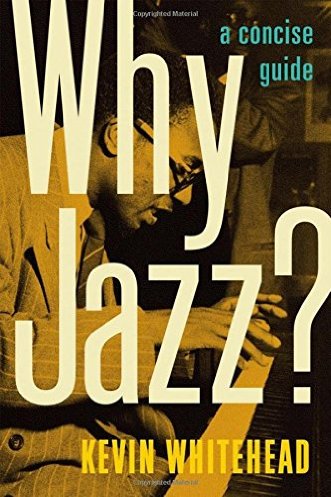Home » Jazz Articles » Book Review » Why Jazz? A Concise Guide
Why Jazz? A Concise Guide
 Why Jazz? A Concise Guide
Why Jazz? A Concise Guide Kevin Whitehead
184 pages
ISBN-10: 0199731187
Oxford, University Press
2011
Small books on big themes are a tough gig. Jazz is a uniquely American, musically challenging, and highly improvisational musical form. Jazz is also a rather vexing topic to explain to the uninitiated (or even to the initiated, who quarrel much over it). Several years ago, I played some late-period work of John Coltrane (the first four minutes of "Transition") to a group of friends at a party held at my home. I asked for silence and concentration, rather rare commodities at parties. One of the uninitiated attenders later confessed to me that she wondered if the people she heard knew how to play their instruments.
Yes, they did. Part of the present problem is that jazz makes up a very small percentage of the music market (the last time I checked it was a paltry 4%); and those depressing numbers may include Kenny G, who, saxophone aside, is not a jazz performer—or an abysmally poor one.
Despite these obstacles, long-time jazz critic, Kevin Whitehead has the chops to distill much of the essence of jazz in Why Jazz? After a fine chapter on "the basics" of jazz, he organizes his material chronologically, instead of thematically, moving from "roots" all way to "jazz after 1980." According to Whitehead, "What is Jazz"? Here is part of his answer. Jazz is a music of rhythmic contrast, featuring personalized performance techniques that usually involve improvisation. It mixes aspects of folk and art music, and its aesthetic reveals a strong African American character (5).
By "rhythmic contrast," Whitehead means syncopation, a concept not easily explained. However, he does so later in the book, defining it as "any deviation from a regular pattern of beats in music, to make rhythms more complex and dynamic; placing a heavy accent on a normally unstressed beat in a bar" (141).
I take slight issue with Whitehead's definition. It seems that jazz always involves improvisation, and almost always group improvisation, where each musician is adjusting to all the others—on the fly. This is part of its essence, a necessary (but not sufficient) condition of its being. Jazz musicians never play the same tune exactly the same way twice. The racial features of jazz are also much-contested (the excellent television series and book Jazz, by Ken Burns [2000] arguable emphasized race over the music itself), but none can deny the formative role played by African Americans, although the contributions of whites and others should not be downplayed.
Every chapter is organized by the interrogative subtitles, modeling the book's title Why Jazz? The first question of chapter one is to the point: "Why listen to jazz?" The last question of the last chapter is, "What is the future of jazz?" This lends a very conversational feel, without being facile. The book also includes the useful features of a glossary, notes, discography, and suggestions for further reading. All these elements make for a superb primer on the music and culture of this fascinating art form.
As a fussy and ardent jazz appreciator, I found no great sins of omission or commission, although small books on big topics must, by definition, be highly selective and make some contested claims. Jazz is not geometry. As a Duke Ellington aficionado, it was heartening to see several pages dedicated to the question, "Why is Duke Ellington revered?" Whitehead is an able guide into the colorful cosmos of jazz. He combines enough musical theory to illustrate key ideas, but does not overwhelm with details that non-musicians would fail to grasp. He does justice to the history and origins of jazz, which is no easy assignment. His job was not to philosophize about jazz, but to introduce the reader to its salient aspects. By doing this, he opens a wide door to a big room where the bands are playing.
< Previous
City Of Poets
Next >
Double Quartet
Comments
Tags
For the Love of Jazz
 All About Jazz has been a pillar of jazz since 1995, championing it as an art form and, more importantly, supporting the musicians who create it. Our enduring commitment has made "AAJ" one of the most culturally important websites of its kind, read by hundreds of thousands of fans, musicians and industry figures every month.
All About Jazz has been a pillar of jazz since 1995, championing it as an art form and, more importantly, supporting the musicians who create it. Our enduring commitment has made "AAJ" one of the most culturally important websites of its kind, read by hundreds of thousands of fans, musicians and industry figures every month.






















